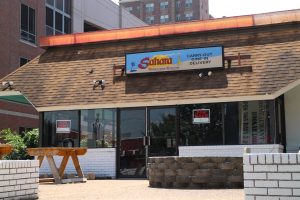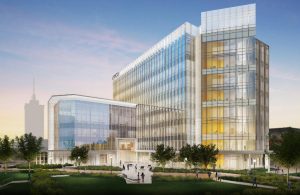Like a mirage in the desert, the Sahara is no more.
The former Sahara restaurant – a holdout in the heart of VCU’s transformation of West Grace Street – was torn down Friday, leaving an even larger void between the towering buildings on either side of it.
The quarter-acre property at 813 W. Grace St. is slated to be used as green space, for now. VCU spokesman Michael Porter has said the property will have a temporary use as an “outdoor student-centered gathering space.” Charlottesville-based Waterstreet Studio is designing the space.
The university purchased the 3,900-square-foot building for $2.5 million in January, part of a $15 million bond package it approved late last year.
The funds from those bonds covered the demolition, which was performed by local firm S.B. Cox. They also funded the purchase of a building at 111 N. Fourth St. and are to be used to refinance existing debt and pay for renovations and improvements to five properties the foundation already owned.
The razing of the Sahara marks a final chapter in the building’s considerable history with VCU.
The restaurant sued the university in 2012, arguing that two neighboring university construction projects were disrupting its business. The case was voluntarily dismissed.
At the time, BizSense reported that Sahara owner Zuhir Idlbi said VCU attempted to buy the property, but he wouldn’t sell.
Built in 1975, the Sahara building and site were collectively assessed at $836,000, according to city records. The property was previously owned by Konstantinos and Ekaterini Hatzigiannidis, who purchased it in 1998 for $350,000.
Meanwhile, soil testing has started on a 2.6-acre tract at 505 W. Leigh St., the site of the former Belvidere Medical Center, which VCU purchased last December. Porter said no decisions have been made as to the use of that property.
On Friday, the VCU Board of Visitors approved the planned demolition of four low-rise dormitories on the MCV Campus: Bear Hall, Warner Hall, Rudd Hall and McRae Hall, all located at 600 N. 10th St.
Those buildings will make way for the planned construction of a new 154,100-square-foot building for the School of Allied Health Professions, an $87.3 million project primarily covered by state-supported debt. University-supported debt will cover $10.8 million of the total project budget, which includes the dorm demolitions.
The new building will house the dean’s office, classrooms, a laboratory, simulation spaces, and relate support spaces. The demolition of the four dorms, each of which is nearly 60 years old, will result in the loss of 294 beds for student housing.
The demolition will take place from August to December, with work on the Allied Health building beginning in January 2017. The new building is expected to be occupied by fall 2019.
EYP Architecture and Engineering is designing the building, and Whiting Turner is the contractor. The demolition will be subcontracted.
Earlier this year, the board approved a $96 million project that will demolish and replace Gladding Residence Center I and II at 711 Main St. on the Monroe Park Campus. Porter said a development agreement with Texas-based American Campus Communities, which VCU is working with on the project, is in the works and could be presented to the board this fall.
Also on Friday, the board approved renovations to the Raleigh Building at 1001 W. Franklin St. on the Monroe Park Campus. The four-story, 26,000-square-foot building was constructed in 1908. The project will total $8.43 million in state general funds.
Williamsburg-based DJG is designing the renovations. The builder will be determined with a competitive bid.
The board also named an architect and engineer for a planned expansion of the School of Engineering Research facility, selecting Baskervill and Goody Clancy & Associates, respectively.
Like a mirage in the desert, the Sahara is no more.
The former Sahara restaurant – a holdout in the heart of VCU’s transformation of West Grace Street – was torn down Friday, leaving an even larger void between the towering buildings on either side of it.
The quarter-acre property at 813 W. Grace St. is slated to be used as green space, for now. VCU spokesman Michael Porter has said the property will have a temporary use as an “outdoor student-centered gathering space.” Charlottesville-based Waterstreet Studio is designing the space.
The university purchased the 3,900-square-foot building for $2.5 million in January, part of a $15 million bond package it approved late last year.
The funds from those bonds covered the demolition, which was performed by local firm S.B. Cox. They also funded the purchase of a building at 111 N. Fourth St. and are to be used to refinance existing debt and pay for renovations and improvements to five properties the foundation already owned.
The razing of the Sahara marks a final chapter in the building’s considerable history with VCU.
The restaurant sued the university in 2012, arguing that two neighboring university construction projects were disrupting its business. The case was voluntarily dismissed.
At the time, BizSense reported that Sahara owner Zuhir Idlbi said VCU attempted to buy the property, but he wouldn’t sell.
Built in 1975, the Sahara building and site were collectively assessed at $836,000, according to city records. The property was previously owned by Konstantinos and Ekaterini Hatzigiannidis, who purchased it in 1998 for $350,000.
Meanwhile, soil testing has started on a 2.6-acre tract at 505 W. Leigh St., the site of the former Belvidere Medical Center, which VCU purchased last December. Porter said no decisions have been made as to the use of that property.
On Friday, the VCU Board of Visitors approved the planned demolition of four low-rise dormitories on the MCV Campus: Bear Hall, Warner Hall, Rudd Hall and McRae Hall, all located at 600 N. 10th St.
Those buildings will make way for the planned construction of a new 154,100-square-foot building for the School of Allied Health Professions, an $87.3 million project primarily covered by state-supported debt. University-supported debt will cover $10.8 million of the total project budget, which includes the dorm demolitions.
The new building will house the dean’s office, classrooms, a laboratory, simulation spaces, and relate support spaces. The demolition of the four dorms, each of which is nearly 60 years old, will result in the loss of 294 beds for student housing.
The demolition will take place from August to December, with work on the Allied Health building beginning in January 2017. The new building is expected to be occupied by fall 2019.
EYP Architecture and Engineering is designing the building, and Whiting Turner is the contractor. The demolition will be subcontracted.
Earlier this year, the board approved a $96 million project that will demolish and replace Gladding Residence Center I and II at 711 Main St. on the Monroe Park Campus. Porter said a development agreement with Texas-based American Campus Communities, which VCU is working with on the project, is in the works and could be presented to the board this fall.
Also on Friday, the board approved renovations to the Raleigh Building at 1001 W. Franklin St. on the Monroe Park Campus. The four-story, 26,000-square-foot building was constructed in 1908. The project will total $8.43 million in state general funds.
Williamsburg-based DJG is designing the renovations. The builder will be determined with a competitive bid.
The board also named an architect and engineer for a planned expansion of the School of Engineering Research facility, selecting Baskervill and Goody Clancy & Associates, respectively.





